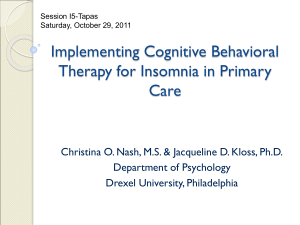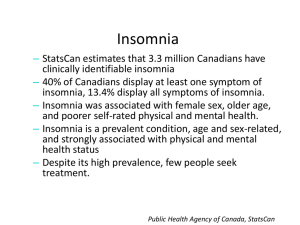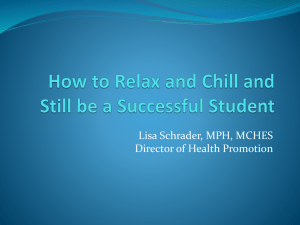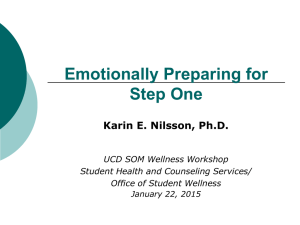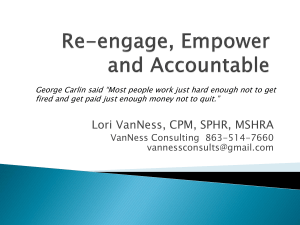VA Training in Cognitive Behavioral Therapy for Depression (CBT-D)
advertisement
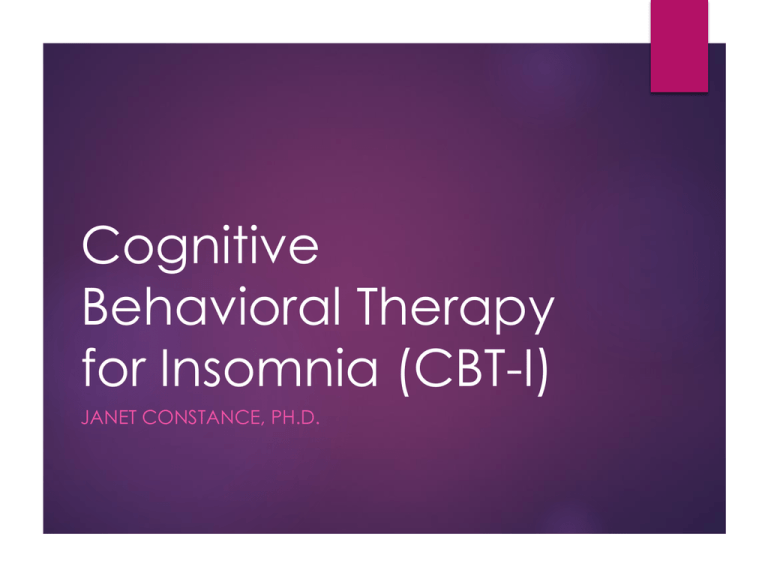
Cognitive Behavioral Therapy for Insomnia (CBT-I) JANET CONSTANCE, PH.D. Acknowledgement Components of this presentation were developed by a group of national VA CBT-I training consultants led by Elissa McCarthy, PhD and sponsored by Mental Health Services, VA Central Office Rachel Manber, PhD (Lead Developer of VA CBT-I Training Program) Jason DeViva, PhD Edward Haraburda, PhD Christie Ulmer, PhD Wendy Batdorf, PhD (VA CBT-I Program Coordinator) What Is Insomnia Disorder? Difficulty initiating sleep, difficulty maintaining sleep, or waking up too early One or more is present at least 3 times a week, for at least 3 months Poor sleep occurs despite adequate opportunity and circumstances for sleep Poor sleep is associated with daytime impairment and distress The Evolution of Insomnia Insomnia Insomnia Threshold No Insomnia Premorbid Acute Insomnia Chronic Insomnia Predisposing Factors Precipitating Factors Perpetuating Factors Adapted from Spielman et al., 2000 Conditioned Insomnia With repeated pairing of bed with wakefulness (high arousal) Tossing Turning Sleeplessness The bed becomes a cue for hyperarousal, rather than sleep Conditioned Insomnia Prevalence of Insomnia Approximately 10% - 15% of adults suffer from chronic insomnia An additional 1/3 have transient or occasional insomnia Approximately 40% of veterans seen by VA primary care Approximately 19% of primary care patients in the general community Medical and Psychiatric Comorbidity Insomnia is frequently comorbid with other medical and psychiatric disorders Having another psychiatric disorder does not preclude diagnosis and treatment of insomnia disorder Comorbid insomnia is often persistent Unlike poor sleep, insomnia disorder does not spontaneously resolve even with successful treatment of a comorbid condition Personal and Societal Costs of Insomnia Associated with a variety of physical, cognitive, and emotional difficulties Disrupted sleep has been shown to reduce productivity, increase healthcare costs, and increase the risk of various medical and psychiatric disorders Poor sleep is associated with several medical conditions (e.g., hypertension, obesity, metabolic syndrome, type 2 diabetes mellitus, all-cause mortality) What is CBT-I? Comprehensive approach targeting factors that maintain insomnia Rooted in the science of sleep/wake regulation and principles of behavior change Skills-based & brief (4-8 sessions) Deliverable in individual or group format CBT-I Components Technique Aims Stimulus Control Strengthen bed & bedroom as sleep cues Sleep Restriction Restrict time in bed to increase sleep drive and consolidate sleep Relaxation, buffer, worry time Arousal reduction Sleep Hygiene Address substance, exercise, eating, environment Cognitive Restructuring Address thoughts and beliefs that interfere with sleep and adherence Circadian Rhythm Entrainment Shift or strengthen the circadian sleep/wake rhythm CBT-I is Effective Is effective among veterans and general population 70% of patients experience full remission of insomnia or dramatic reduction in symptoms Improves sleep initiation Reduces time awake in the middle of the night Recommended as a first-line of treatment of insomnia Practice parameters published by the American Academy of Sleep Medicine NIMH state of the science consensus statement Comparative Efficacy: CBT-I for Sleep Onset Difficulties Sleep Onset Latency 90 80 83.5 Sleep Efficiency 80.4 POST-TREATMENT 70 71.3 67.2 60 63.9 58.7 50 40 30 38.7 34.1 20 10 0 CBT Jacobs et al., 2004 Zolpidem Combination Placebo Minutes awake after sleep onset Comparative Efficacy: CBT-I for Sleep Maintenance Difficulties 90 80 70 60 CBTI (18) 50 Temazepam (20) 40 Combined (20) 30 Placebo (20) 20 10 0 Baseline Post3 Months 12 Months Treatment Follow-up Follow-up Adapted from Morin et al., JAMA 1999 24 months Follow-up How does Sleep Hygiene differ from CBT-I? Sleep Hygiene Education Sleep Hygiene ≠ CBT-I Avoid stimulants for several hours before bedtime. Avoid alcohol around bedtime. Exercise regularly. Allow at least a 1-hour period to unwind before bedtime. • Keep the bedroom environment quiet, dark and comfortable. • Maintain a regular sleep schedule. • • • • CBT-I Sleep Restriction Stimulus Control Relaxation Training Cognitive Therapy Sleep Hygiene Education (except for regular bedtime) • Cognitive Therapy • • • • • Standard Guidelines Individualized Multi-Component Intervention Helps Normal Sleepers Maintain Sleep Health Treatment for Insomnia Disorder Preventive Curative The Dental Hygienist The Dentist Minimal Impact on Insomnia Disorder Very Effective Insomnia Disorder Treatment Inactive Condition in Insomnia Research Active Condition in Insomnia Research Reasons to Refer for CBT-I No risk of drug interactions Minimizes risk for confused arousal upon awakening Benefits continue (and often increase) even after treatment is discontinued Brevity and effectiveness of approach Involves behavioral changes that improve quality of life in general such as winding down before bed Patients feel empowered by not relying on medication to sleep (increased self-efficacy) VA CBT for Insomnia Training Program CBT-I and Comorbidities Experienced CBT-I providers can tailor CBT-I for patients with complex presentations such as: A history of alcohol and drug abuse (but are not currently abusing) Comorbid psychiatric or medical conditions, even those known to impact sleep For example, bipolar disorder, pain conditions, and seizure disorder Comorbid sleep disorders such as sleep apnea Contraindications CBT-I is NOT indicated when patient: Does not meets criteria for insomnia disorder (e.g., inadequate time allowed for sleep, shift work disorder) Is engaged in exposure therapy for PTSD Is working night or rotating shifts CBT-I Referral Sources American Board of Sleep Medicine Society of Behavioral Sleep Medicine http://www.behavioralsleep.org/FindSpecialist.aspx American Academy of Sleep Medicine http://www.absm.org/BSMSpecialists.aspx http://www.aasmnet.org/ National Sleep Foundation http://sleepfoundation.org/find-sleep-professional VA CBT-I Resources CBT-I Sharepoint (only accessible by VA providers) https://vaww.portal.va.gov/sites/omhs/cbt_insomnia/ default.aspx VA CBT-I provider list CBT-I patient brochures CBT-I Clinician Factsheet Questions?


